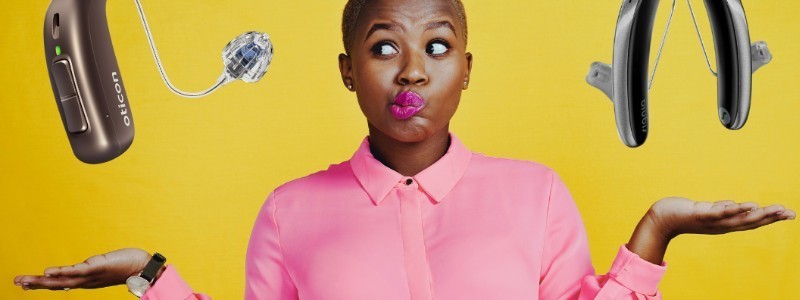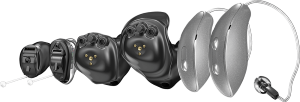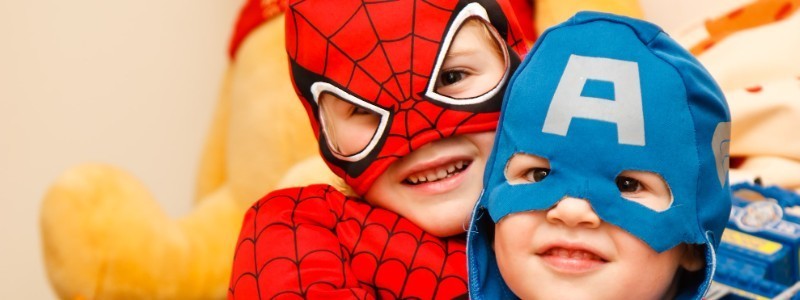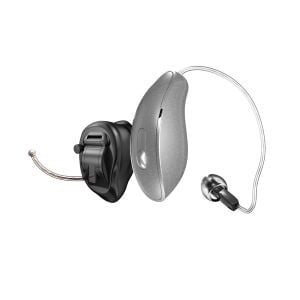
Head of Online Medical Content

Audiology Expert at Hearing Aid UK

What is the best way to insert a hearing aid?
Plus, how to stop your hearing aids from falling off
How to insert In-Ear hearing aids | How to insert Behind the Ear with Mould (BTE) hearing aids | How to insert Behind the Ear Open Fit hearing aids | How do you keep hearing aids from falling off?
Is there a better way to insert my hearing aids?
One of the common questions we get asked is how to insert hearing aids the right way. Ensuring optimal performance of your hearing aid hinges on proper insertion. A snug fit not only curbs feedback (or whistling) but also guarantees a comfortable placement for you.
In this article, we take a look at the different hearing aid models and how to put them in securely and safely. Remember that no matter which hearing aid type you wear, red is for the right ear and blue is for the left ear.
For any type of hearing aid, follow these simple steps for proper insertion, including specific instructions for children:
How to insert In the Ear (ITE), In the Canal (ITC), and Completely in Canal (CIC) hearing aids:
- Position the hearing aid's tip in your ear canal.
- Gently tug your ear and insert the hearing aid into the ear canal, adjusting its position to align with the ear canal's natural contour.
(Caution: Do not use the battery door as a handle for insertion or removal as it's not intended for this purpose.)
How to insert Behind the Ear with Mould (BTE) hearing aids:
- Twist the tip of the ear mould into the ear canal, ensuring the top part of the ear mould (A) is tucked behind and beneath the fold (B) of the ear.
- Pull the ear upward gently and guide the ear mould towards the ear canal.
- Place the hearing aid behind the ear by lifting the base over the top of the ear.

How to insert Behind the Ear Open Fit hearing aids:
- Hold the hearing aid behind your ear with the soft tip facing inward.
- Insert the soft tip into the ear, allowing the tail to face outward.
- Fold the tail into the ear's bowl.
Inserting hearing aids for children:
- Power off or minimise the volume to prevent whistling.
- Grasp the tubing close to the ear mould and tilt the instrument forward slightly, carefully inserting the canal portion of the ear mould into the ear canal.
- Twist the ear mould back into place and tuck the instrument behind the ear, ensuring the tubing remains untwisted. Verify the snug fit by tracing the ear's contour with your finger.
- Activate the instrument and adjust the volume as needed. Note that the audiologist may have disabled the volume control in some cases.
(Caution: When removing the instrument, handle the ear mould gently and avoid tugging the tubing.)

How do you keep hearing aids from falling off?
Plus, how do you keep hearing aids on children?
Real-life question example
"Upon my initial trial of the hearing aids, I was confident in their perfect fit. However, upon returning home and engaging in more movement, it became evident that they were not securely staying in place. I fear they might come off and be accidentally trodden upon.
This situation could potentially become highly bothersome unless I find a solution to ensure their stability, especially considering they were tailored to my ears with precise measurements. What other measures can I take to ensure these hearing aids remain firmly secured at all times?"
Our response
"Initially, it is imperative to reach out to your hearing aid audiologist. Properly fitted hearing aids should not dislodge during regular use. Several strategies exist to guarantee the secure placement of the aids. Avoiding the scenario where they might fall out and risk being misplaced or damaged is crucial".
Real-life question example
"Our five-year-old boy recently received his first set of hearing aids, leading to increased engagement and attentiveness. However, he consistently removes them in our absence, stating they are comfortable.
Yet, we frequently find them off or misplaced, likely due to his rough play. Could you provide us with some suggestions on how to ensure that hearing aids remain securely on children?"
Our response
"This is a matter where consulting a hearing aid audiologist may not be the most suitable option. I assume you acquired these hearing aids through the NHS and are currently under their care? The NHS offers a commendable service for children with hearing impairments, and they are undoubtedly equipped to provide you with the necessary guidance".
Why Choose Us?
- FREE Hearing Tests
- Best Hearing Aids and Prices
- FREE Aftercare for Life
- FREE Home Visits
- 200+ Local Audiologists
- 60 Day Money Back Guarantee
The importance of inserting your hearing aids correctly
Proper insertion of a hearing aid is pivotal for optimal functionality and user comfort.
A secure fit not only minimises feedback and potential discomfort but also ensures the device functions at its best, allowing individuals to engage fully with their environment.
Correct placement is essential in preventing mishaps such as accidental removal or damage, especially in active scenarios.
Other hearing aid technology articles you might like...
 Starkey Edge AI Hearing Aids VS Starkey Genesis AI
Starkey Edge AI Hearing Aids VS Starkey Genesis AI  Phonak Audeo Infinio VS Phonak Lumity Hearing Aids
Phonak Audeo Infinio VS Phonak Lumity Hearing Aids  What is Auracast? Is it better than Classic Bluetooth?
What is Auracast? Is it better than Classic Bluetooth? What's included in our hearing aid prices?
Our specialist service includes:
Do not spend hundreds of pounds without getting a second opinion from us.
Please call us on 0800 567 7621
 Not only are the prices great, but the service is fantastic! Many thanks to your team.
Not only are the prices great, but the service is fantastic! Many thanks to your team.Other pages you might find useful
Ask the Experts
6 Morton Lane
Walkwood
Redditch
Worcestershire
B97 5QA
Latest Launch
When we refer to a product as 'Latest Launch', we mean it is the latest to be released on the market.
New
When we refer to a product as 'New', we mean that the product is the newest hearing aid model on the market.
When we refer to a product as 'Superseded', we mean that there is a newer range available which replaces and improves on this product.
Older Model
When we refer to a product as an 'Older Model', we mean that it is has been superseded by at least two more recent hearing aid ranges.
